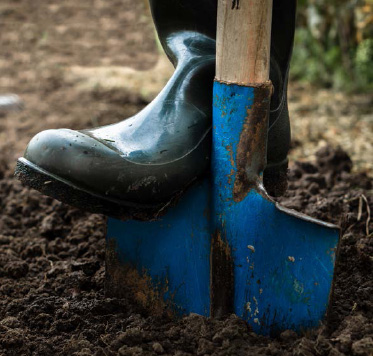
Advice and inspiration for cultivating a better life.

Introduction
Do you dream of having a farmhouse on a little piece of land in the country with a garden full of fresh vegetables, a raspberry bramble, and an endless supply of eggs from a flock of chickens? Are you already living that dream? Either way, this book is your guide to a better life. Its for those who desire to escape the chaos and overstimulation of city life and seek the peace of the country. Its for those who long to grow and raise their own foodand to prepare it in fresh, wholesome, unadulterated ways. Its for those who want to shepherd a flock of sheep or a herd of goatsand to learn the art of cheesemakingor to plant a garden that will attract pollinators such as hummingbirds or bees. Get started as a beekeeper or a bunnykeeper. Make your own soap, herbal spa products, or a wine rack from reclaimed wood. The information, tips and projects in this user-friendly guide are relevant to anyone who seeks to cultivate a patch of paradise on earthwhether you have a rural zip code and are looking for practical advice or if youre an armchair homesteader who simply wants to bring a bit of the country into your life.
CHAPTER 1
Edible Gardening
Raising your own fruits and vegetables allows you to connect to the Earth in a personal way. And when you grow your own food, youll be amazed at how fresh food can taste: Sun-warmed tomatoes, crisp apples, and savory greens have a flavor all their own when they are eaten moments after harvest. And youll enjoy more choices: You can grow exotic heirlooms and new varieties that you cant find in grocery stores.

PLANT FLOWERS WITH FOOD
Interplant flowers with vegetables to create a beautiful (and delicious!) garden. Experiment with planting in blocks and clusters rather than rows for a more decorative effect.

2 KNOW YOUR SOIL
Identify your soil type and then determine the best way to improve it.
How would you characterize your soil? Is it poor, boggy muck that drains poorly and lacks nutrients? Could it be the red clay of Georgia, the sandy clay of Texas, or the caliche (sandy, rocky, alkaline stuff) of Arizona? You must identify your soil before improving itwhether it needs fertility, absorbency, or drainability. Here are soil options:
LOAM The ideal soil holds air, water, and nutrients in a balance of sand, silt, clay, and organic matter. Its easy to work. A handful of loam holds its shape when squeezed and crumbles when squeezed harder. If well-drained, it leaches nutrients and warms slowly. Add worm castings, rotted manure, and organic matter (compost and chopped leaves) to improve it.
CLAY This heavy, poorly draining stuff forms a sticky, hard mass when squeezed. Plant roots have a hard time growing in clay soil; they may die due to lack of air and water. Improve it with loads of organic matter, such as grass clippings, chopped leaves, old hay, ground bark or wood shavings, and gypsum.
SAND Sand holds too much air; it holds neither water nor nutrients. A handful crumbles and wont form a ball. It tills easily and warms up quickly. Improve it by adding organic matter: compost, rotted manure, and chopped leaves.

3 TEST, TESTING 1-2-3
Soil testing sounds difficult and fussy and technical, but its actually pretty simple. Heres how to do it:
STEP 1 Fill a quart (1 L) jar about one-third full with soil. Then fill the rest of the jar with water. Screw on the lid.
STEP 2 Give the jar a robust shake to break up the clumps.
STEP 3 Put the jar down. Do nothingunless you want to watch it settle. Let it sit overnight.
STEP 4 Grab a permanent marker. Draw on the jar where the level of the sand is. Then draw a line where theres silt and, finally, clay.
Those lines can help you approximate what your soil is. Loam should be about 30 to 40 percent sand, 30 to 40 percent loam, and 20 percent clay.

4 BUILD BETTER SOIL
Apply amendments individually or in combination each season. Spread compost, manure, and peat 3 inches (8 cm) deep on top of soil and work into the top 3 to 6 inches (8 to 15 cm); apply inch (12 mm) or less of sand, greensand, and vermiculite, perlite, or gypsum; and work into the top 8 inches (20 cm) of soil.
These materials help improve soils fertility and its capacity to hold and drain moisture:
COMPOST Decomposed leaves, grass clippings, plant-based kitchen scraps, and other organic materials. A well-balanced, slow-release, nutrient-and humus-rich amendment. Lightens heavy soils; enriches poor soil.
SAND Coarse sand in small amounts improves drainage and loosens clay soil. Too much sand turns some soils into concrete. Contains no nutrients but lasts indefinitely.
MANURE Aged or rotted manure (from cows, horses, sheep, goats, chicken, or pigs) boosts levels of soil nitrogen, loosens heavy soil, and improves water retention in light soils. Fresh manure burns plants; compost it for a full year before using.
PEAT Absorbs moisture; especially helpful in sandy soil. Loosens heavy or clay soils. If allowed to dry out, it can become hard, crusty, and difficult to remoisten, so keep it lightly damp. Peat or peat moss may be harvested from environmentally fragile peat bogs, a limited resource. Use sphagnum peat moss instead.
VERMICULITE Made by heating mica until it bursts, this lightweight particulate holds moisture and loosens soil. Good in all soil types. Lasts indefinitely.
PERLITE White volcanic residue that aerates soil and lasts indefinitely. Good for all soil types; a little helps.
GREENSAND Powdered rock that contains potassium and other nutrients. Slows soil compaction and helps retain moisture.
GYPSUM Powdered mineral that loosens heavy and clay soil; improves drainage. Gypsum is useful in changing the texture of soil that has been packed down by heavy traffic, flooding, or weather.
GET A NUTRIENT BOOST
Basic Nutrients Fertilizers contain all of the basic nutrients: nitrogen, phosphorus, and potassium. These are listed on packaged plant foods in percentages of N-P-K. Or add these organic materials to soil.
Nitrogen (N) Sources for Leaf and Stem Growth Alfalfa meal, blood meal, composted manure, cottonseed meal, feather meal, fish meal or emulsion, mushroom compost, rice hulls
Phosphorus (P) Sources for Root Growth, Flower Color, and Disease Resistance Bat guano, bonemeal, rock phosphate
Potassium (K) Sources for Fruit and Seed Production Dolomite lime, greens and, kelp meal, oyster-shell lime, rock dust, seaweed, wood ashes





















